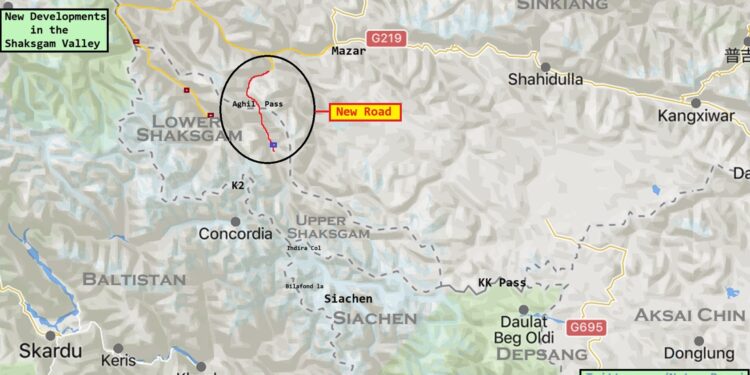OPED By Karan Sharma
China’s recent construction of a road in the Shaksgam Valley, a disputed region along the borders of the Chinese province of Xingjiang and Pakistan-occupied Kashmir (PoK), has reignited tensions in the already volatile region.
The latest reports suggest that the Indian army is analyzing the strategic impact of the new road, which enters the lower Shaksgam valley from the Aghil Pass. The road infrastructure has been under development since June 2023, with construction efforts resuming in the summer of 2024.
Currently, its endpoint is a mere 30 miles from the Indian position over the Siachen Glacier. The Shaksgam Valley, part of the larger Trans-Karakoram tract, has been a contentious issue since its transfer by Pakistan to the People’s Republic of China (PRC) under the 1963 Sino-Pakistan Agreement. This transfer, regarded by India as illegal, has fueled longstanding territorial disputes in the northern areas of PoK and Ladakh.
Today, the Trans-Karakoram tract has become a focal point of geopolitical significance, mainly due to the China-Pakistan Economic Corridor (CPEC).
The CPEC, a flagship project under China’s Belt and Road Initiative (BRI), aims to connect China’s Xinjiang province to Pakistan’s Gwadar Port through a network of energy, logistics, and transportation-related infrastructure projects.

However, the corridor passes through disputed territories of PoK, particularly Gilgit-Baltistan, which makes the Chinese-funded project unacceptable to India. This latest road construction in the lower Shaksgam Valley through the Aghil Pass has added another layer to the complex web of territorial disputes in Northern Ladakh.
The new road extending closer to the Siachen Glacier, a region of strategic importance for India due to its high altitude, which provides a dominant military position, directly challenges India’s security interests in the India-Pakistan-China trisection near Siachen.
India has consistently opposed Chinese infrastructure projects in PoK, viewing them as a violation of its territorial integrity. The emergence of a second Chinese road intersection in the Karakoram, this time through the Aghil Pass in the Shaksgam Valley, represents a significant development; the pre-existing route in the PoK, i.e., National Highway 35/G-314 through the Khunjerab Pass, serves as a vital link of the CPEC, now constructing an alternative route through the Shaksgam Valley introduces a new dynamic.
There can be multiple potential objectives behind China’s actions in Shaksgam, each carrying significant implications for India. One plausible objective behind China’s activity in the Shaksgam Valley is to reduce its reliance on the Khunjerab Pass for the CPEC.
The existing route through the Khunjerab Pass, particularly the Karakoram Highway, is vulnerable to disruption during times of conflict, primarily due to the threat of an Indian aerial offensive.
By constructing an alternative route through the Shaksgam Valley, China aims to mitigate this vulnerability and ensure uninterrupted connectivity with Pakistan, thereby safeguarding its strategic interests.
Secondly, China’s actions in the Shaksgam Valley can be interpreted as a move to assert its permanent claim over the territory. India has long contested the transfer of the Shaksgam Valley from Pakistan to China in 1963; the recent infrastructure development in the region serves to solidify China’s presence and signals to India that the transfer of the Shaksgam Valley was not merely symbolic.
Thirdly, China’s activities in the Shaksgam Valley may also be aimed at neutralizing India’s strategic advantage in the Karakoram and Trans-Karakoram tract, particularly due to the uninterrupted Indian presence over the Siachen Glacier since the Kargil conflict of 1999.
India’s military presence in Siachen, occupying high-ground positions, has historically provided it with a strategic advantage in the Karakoram sector. By establishing infrastructure in the Shaksgam Valley, China seeks to counterbalance India’s advantage and potentially pose challenges to its military posture in the area.
This reflects China’s strategic calculus to recalibrate the balance of power along the disputed border regions, particularly in Northern Ladakh.

The implications of this development are concerning for India, as it brings twin threats in close proximity to the Siachen Glacier. With China now asserting its presence in the north of the valley and Pakistan maintaining its military presence to the west and south, India faces a complex security challenge that requires careful navigation and strategic planning.
While the current road is located in the lower Shaksgam Valley, further construction in the Upper Shaksgam Valley could bring Chinese posts and road infrastructure within 10 to 15 km of Siachen, posing a direct threat to India’s position.
The situation is compounded by the ongoing conflict between India and China in the Depsang plains sector just to the East of Siachen, which has witnessed unprecedented mobilization by both sides since the Galwan conflict in June 2020.
As the conflict enters its fifth year, the potential for further escalation remains a cause for concern. In response to China’s provocative actions in the Shaksgam Valley, the Ministry of External Affairs (MEA) spokesperson, Randhir Jaiswal, has announced that India has lodged a formal protest with China.
Infrastructure construction in the Shaksgam Valley is not an isolated incident but part of a broader pattern of Chinese expansionism along the Line of Actual Control (LAC) and its borders with neighboring countries.
Similar developments have been observed in regions such as Doklam near the India-Bhutan-China trijunction, Aksai Chin, and the Namka Chu Valley in Upper Tawang along the border of Arunachal Pradesh.
Indian strategist Brahma Chellaney has aptly characterized China’s strategy as “salami-slicing,” wherein it incrementally gains strategic advantages in contested areas without escalating conflicts into overt battles. This gradual but persistent approach allows China to expand its influence and alter the ground situation in its favor while avoiding significant pushback.
Moreover, recent comments by retiring Admiral John Aquilino, the former US Pacific commander, shed light on China’s broader strategy of aggressive expansionism.
Admiral Aquilino has likened China’s tactics to a “boiling frog” strategy, wherein it gradually raises the threshold of aggression until other nations fail to realize the critical point in a conflict. This strategy has been evident in the South China Sea, where China has incrementally militarized disputed islands and reefs, leading to heightened tensions with neighboring countries and the United States.
The situation in the Himalayan theater is no exception, as Chinese expansionist activities along the LAC demonstrate. The gradual but persistent development of military infrastructure poses a significant challenge to regional stability and security.
India must remain vigilant and proactive in countering these threats, both diplomatically and militarily, to safeguard its interests and prevent further encroachments on its territory. In conclusion, China’s actions in the Shaksgam Valley are part of a broader pattern of expansionism and strategic maneuvering in the region.

India’s response must be robust and multifaceted, incorporating diplomatic protests, enhanced military preparedness, and closer engagement with regional partners to address the challenges of Chinese assertiveness effectively.
India must bolster its border security measures to prevent further Chinese encroachments and incursions. This may involve deploying additional troops and enhancing surveillance capabilities to deter any further attempts by China to alter the status quo.
India recently sent an additional 10,000 troops to the middle LAC sector of Himachal Pradesh and Uttarakhand in March, just before the commencement of the national elections; this extra strength is over and above the 50,000 troops deployed in 2021.
India can also explore applying sanctions targeting Chinese companies involved in infrastructure projects in disputed territories. By imposing economic costs on China, India can send a strong message that unilateral actions will not be tolerated.
Collaborative efforts with countries such as the United States, Japan, Australia, members of the QUAD and AUKUS can provide India with additional diplomatic leverage and intelligence support in countering Chinese aggression.
Reports of crucial American intelligence during the Galwan conflict with China strengthen the case for increased intelligence sharing and developing India’s own intelligence infrastructure along the LAC and Tibet.
By adopting a comprehensive and proactive approach, India can effectively respond to Chinese transgressions in the border areas and safeguard its territorial integrity and national security interests. It is essential to send a clear message to China that any attempts to alter the status quo will be met with a robust and resolute response from India.
- Karan Sharma is a Senior Research Fellow at the Department of Humanities and Social Sciences at BITS-Pilani Goa.
- Views personal of the author





